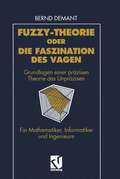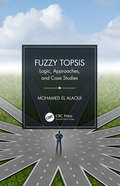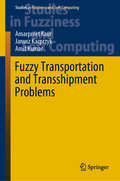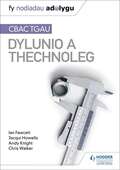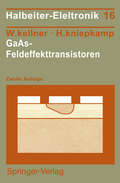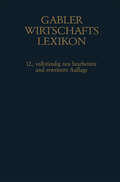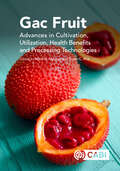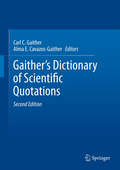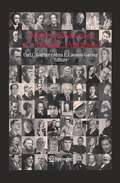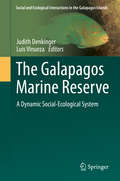- Table View
- List View
Fuzzy Systems Design: Social and Engineering Applications (Studies in Fuzziness and Soft Computing #17)
by Leonid Reznik Vladimir DimitrovFuzzy logic is a way of thinking that is responsive to human zeal to unveil uncertainty and deal with social paradoxes emerging from it. In this book a number of articles illustrate various social applications to fuzzy logic. The engineering part of the book contains a number of papers, devoted to the description of fuzzy engineering design methodologies. In order to share the experience gained we select papers describing not the application result only but the way how this result has been obtained, that is explaining the design procedures. The potential readership of this book includes researchers and students, workers and engineers in both areas of social and engineering studies. It can be used as a handbook and textbook also. The book includes some examples of real fuzzy engineering.
Fuzzy Systems Engineering: Toward Human-Centric Computing (Wiley - IEEE)
by Witold Pedrycz Fernando GomideA self-contained treatment of fuzzy systems engineering, offering conceptual fundamentals, design methodologies, development guidelines, and carefully selected illustrative material Forty years have passed since the birth of fuzzy sets, in which time a wealth of theoretical developments, conceptual pursuits, algorithmic environments, and other applications have emerged. Now, this reader-friendly book presents an up-to-date approach to fuzzy systems engineering, covering concepts, design methodologies, and algorithms coupled with interpretation, analysis, and underlying engineering knowledge. The result is a holistic view of fuzzy sets as a fundamental component of computational intelligence and human-centric systems. Throughout the book, the authors emphasize the direct applicability and limitations of the concepts being discussed, and historical and bibliographical notes are included in each chapter to help readers view the developments of fuzzy sets from a broader perspective. A radical departure from current books on the subject, Fuzzy Systems Engineering presents fuzzy sets as an enabling technology whose impact, contributions, and methodology stretch far beyond any specific discipline, making it applicable to researchers and practitioners in engineering, computer science, business, medicine, bioinformatics, and computational biology. Additionally, three appendices and classroom-ready electronic resources make it an ideal textbook for advanced undergraduate- and graduate-level courses in engineering and science.
Fuzzy Systems in Bioinformatics and Computational Biology (Studies in Fuzziness and Soft Computing #242)
by Yaochu Jin Lipo WangBiological systems are inherently stochastic and uncertain. Thus, research in bioinformatics, biomedical engineering and computational biology has to deal with a large amount of uncertainties. Fuzzy logic has shown to be a powerful tool in capturing different uncertainties in engineering systems. In recent years, fuzzy logic based modeling and analysis approaches are also becoming popular in analyzing biological data and modeling biological systems. Numerous research and application results have been reported that demonstrated the effectiveness of fuzzy logic in solving a wide range of biological problems found in bioinformatics, biomedical engineering, and computational biology. Contributed by leading experts world-wide, this edited book contains 16 chapters presenting representative research results on the application of fuzzy systems to genome sequence assembly, gene expression analysis, promoter analysis, cis-regulation logic analysis and synthesis, reconstruction of genetic and cellular networks, as well as biomedical problems, such as medical image processing, electrocardiogram data classification and anesthesia monitoring and control. This volume is a valuable reference for researchers, practitioners, as well as graduate students working in the field of bioinformatics, biomedical engineering and computational biology.
Fuzzy-Systems in Computer Science (Computational Intelligence)
by Rudolf Kruse Jörg Gebhardt Rainer (Eds.) PalmThis book contains a selection of revised papers and state-of-the-art overviews on current trends and future perspectives of fuzzy systems. A major aim is to address theoretical as well as application-oriented issues and to contribute to the foundation of concepts, methods, and tools in this field. The book is written by researchers who attended the workshop "Fuzzy Systems '93 - Management of Uncertain Information" (Braunschweig, Germany, October 21-22, 1993), organized by the German Society of Computer Science (GI), the German Computer Science Academy (DIA), and the University of Braunschweig.Dieses Buch enthält ausgewählte und auf neuesten Stand gebrachte Fachaufsätze und "State of the Art"-Übersichtsartikel in englischer Sprache. Sie geben einen Überblick über aktuelle Trends sowie Zukunftsperspektiven der Fuzzy-Systeme. Besonderer Wert wird darauf gelegt, daß das Buch in einem ausgewogenen Verhältnis von Theorie und Praxis zur Fundierung von Konzepten, Methoden und Werkzeugen beiträgt. Hervorgegangen ist das Werk aus einem von der Gesellschaft für Informatik (GI), der Deutschen Informatik Akademie (DIA) und der TU Braunschweig gemeinsam veranstalteten GI-Workshop "Fuzzy-Systeme '93 - Management unsicherer Informationen" (Braunschweig, 21.-22.10.1993). Die Aufsätze wurden überarbeitet und um Überblicksartikel ergänzt, geschrieben von H. J. Zimmermann, H. Hellendorn, D. Nauck, C. Freksa, S. Gottwald und K. D. Meyer-Gramann.
Fuzzy Technologien: Prinzipien, Werkzeuge, Potentiale (VDI-Buch)
by H. J. ZimmermannDas vorliegende Werk, ist vorwiegend als eine Einführung für Praktiker gedacht, die sich mit dem Gebiet der Fuzzy Technologien beschäftigen wollen und weniger an tiefgehender Mathematik, mehr jedoch an anwendbarer Technologie interessiert sind. So werden nur die aus Anwendersicht relevanten theoretischen Grundlagen dargestellt, gefolgt von Beispielen existierender Anwendungen. Die weiteren Bände der Reihe Intelligente Technologien widmen sich aktuellen Anwendungen der Fuzzy Technologien sowie anderen intelligenten Ansätzen, die im Verbund mit Fuzzy Sets interessante Problemlösungen darstellen.
Fuzzy Technology: Present Applications and Future Challenges (Studies in Fuzziness and Soft Computing #335)
by Mikael Collan Mario Fedrizzi Janusz KacprzykThis book provides readers with a timely and comprehensive yet concise view on the field of fuzzy logic and its real-world applications. The chapters, written by authoritative scholars in the field, report on promising new models for data analysis, decision making, and systems modeling, with a special emphasis on their applications in management science. The book is a token of appreciation from the fuzzy research community to Professor Christer Carlsson for his long time research and organizational commitment, which have among other things resulted in the foundation and success of the Institute for Advanced Management Systems Research (IAMSR) at Åbo Akademi University, in Åbo (Turku), Finland. The book serves as timely guide for the fuzzy logic and operations research communities alike.
Fuzzy-Theorie oder Die Faszination des Vagen: Grundlagen einer präzisen Theorie des Unpräzisen für Mathematiker, Informatiker und Ingenieure
by Bernd DemantThe Journal of Business Market Management (JBM) explores all facets of business-to-business marketing, industrial market management and marketing of business services. That includes the areas of technical and commercial sales management but also industrial supply and business buying behavior. Academics as well as practitioners thinking will be enriched with novel and significant ideas in terms of research approaches and results. Offering a combination of conceptual papers, empirical research analyses, and case study arti-cles the journal represents a valuable knowledge source and contributes to a better understanding of busi-ness market activities.
Fuzzy Theorie und Stochastik: Modelle und Anwendungen in der Diskussion (Computational Intelligence)
by Wolfgang Bibel Rudolf KruseDas Buch stellt der Fuzzy-Theorie die "klassische" Stochastik gegenüber und charakterisiert ihr Anwendungspotential anhand von Beispielen. Die zu diesem Zweck gesammelten Beiträge stellen neben den Grundlagen dieser beiden Theorien auch den geschichtlichen Aspekt dar. Insgesamt zeigen die Beiträge, dass bei allen theoretischen Divergenzen letztlich auf beiden Seiten Erfolge zu verzeichnen sind, die dem Anwender in Industrie und Wirtschaft Vorteile bringen. Lange Zeit war die Wahrscheinlichkeitstheorie die einzige mathematische Theorie, die den Aspekt der Ungewißheit berücksichtigte. In den 60er Jahren entstand mit der Fuzzy-Theorie eine weitere "Ungewißheitstheorie". Sie gilt als eine radikal andere Art von Mathematik mit vagen Größen, zu deren Behandlung sich die Wahrscheinlichkeitstheorie nicht eignet. Massive Kritik an dieser wissenschaftlichen Theorie kommt von Seiten der Wahrscheinlichkeitstheoretiker und Statistiker.
Fuzzy TOPSIS: Logic, Approaches, and Case Studies
by Mohamed El AlaouiThis book aims to justify the use of fuzzy logic as a logic and as a theory in the decision-making context. It also discusses the development of the TOPSIS method (Technique for Order of Preference by Similarity to Ideal Solution) with related examples and MATLAB codes. This is the first book devoted to TOPSIS and its fuzzy versions. It presents the use of fuzzy logic as a logic and as a theory in the decision-making content and discusses the development of the TOPSIS method in classical and fuzzy context. The book justifies the use of fuzzy logic as an uncertainty theory and provides illustrative examples for each fuzzy TOPSIS extension, along with related MATLAB codes and case studies. This book is for Industrial Engineers, Operations Research Engineers, Systems Engineers, and Production Engineers working in the areas of Decision Analysis, Multi-Criteria Decision Making, and Multiple Objective Optimization.
Fuzzy TOPSIS: Logic, Approaches, and Case Studies
by Mohamed El AlaouiThis book aims to justify the use of fuzzy logic as a logic and as a theory in the decision-making context. It also discusses the development of the TOPSIS method (Technique for Order of Preference by Similarity to Ideal Solution) with related examples and MATLAB codes. This is the first book devoted to TOPSIS and its fuzzy versions. It presents the use of fuzzy logic as a logic and as a theory in the decision-making content and discusses the development of the TOPSIS method in classical and fuzzy context. The book justifies the use of fuzzy logic as an uncertainty theory and provides illustrative examples for each fuzzy TOPSIS extension, along with related MATLAB codes and case studies. This book is for Industrial Engineers, Operations Research Engineers, Systems Engineers, and Production Engineers working in the areas of Decision Analysis, Multi-Criteria Decision Making, and Multiple Objective Optimization.
Fuzzy Transportation and Transshipment Problems (Studies in Fuzziness and Soft Computing #385)
by Amarpreet Kaur Janusz Kacprzyk Amit KumarThis book presents a novel approach to the formulation and solution of three classes of problems: the fully fuzzy transportation problem, the fully fuzzy transshipment problem, and fully fuzzy solid transportation problem. It points out some limitations of the existing formulations and approaches, indicating some possible, conceptually and algorithmically attractive solutions to alleviate them. In particular, the book describes new conceptual and algorithmic solutions for finding the fuzzy optimal solutions of the single-objective fully fuzzy transportation problems, the fully fuzzy transshipment problems and the fully fuzzy solid transportation problems. Moreover, based on the novel concepts and solutions proposed by combining the concept of a fully fuzzy solid transportation problem and a fully fuzzy transshipment problem, it describes a new class of problems, i.e. the fully fuzzy solid trans-shipment problem, together with its fuzzy linear programming formulation and some methods to find its fuzzy optimal solution. The book offers the readers a timely piece of literature in the field of fuzzy linear programming, and is expected to act as a source of inspiration for future research and applications.
Fy Nodiadau Adolygu: CBAC TGAU Dylunio a Thechnoleg (My Revision Notes: WJEC GCSE Design and Technology Welsh-language edition)
by Ian Fawcett Jacqui Howells Andy Knight Chris WalkerTarget success in WJEC GCSE Design and Technology with this proven formula for effective, structured revision. Key content coverage for Engineering Design, Fashion and Textiles and Product Design is combined with exam-style tasks and practical tips to create a revision guide that you can rely on to review, strengthen and test your knowledge.With My Revision Notes you can:- plan and manage a successful revision programme using the topic-by-topic planner- consolidate subject knowledge by working through clear and focused content coverage- test understanding and identify areas for improvement with regular 'Now Test Yourself' tasks and answers- improve exam technique through practice questions, expert tips and examples of typical mistakes to avoid
G.H.A. Kröhnkes Taschenbuch zum Abstecken von Bögen auf Eisenbahn- und Weglinien
by R. SeifertDieser Buchtitel ist Teil des Digitalisierungsprojekts Springer Book Archives mit Publikationen, die seit den Anfängen des Verlags von 1842 erschienen sind. Der Verlag stellt mit diesem Archiv Quellen für die historische wie auch die disziplingeschichtliche Forschung zur Verfügung, die jeweils im historischen Kontext betrachtet werden müssen. Dieser Titel erschien in der Zeit vor 1945 und wird daher in seiner zeittypischen politisch-ideologischen Ausrichtung vom Verlag nicht beworben.
G. V. Schulz: Leben und Forschen eines Polymer-Pioniers im 20. Jahrhundert
by Sebastian SeiffertProf. Dr. Günther Viktor Schulz, ein bedeutender Wissenschaftler des 20. Jahrhunderts, prägte ganz wesentlich das Gebiet der Polymerchemie. Sein Leben und Wirken in den Wirren dieser Epoche war erfüllt von wissenschaftlichen Entdeckungen und schicksalhaften Begegnungen. Das vorliegende Werk stellt eine private Niederschrift seiner persönlichen Lebens- und Arbeitserinnerungen bereit.
G.W. Stewart: Selected Works with Commentaries (Contemporary Mathematicians)
by Misha E. Kilmer Dianne P. O'LearyPublished in honor of his 70th birthday, this volume explores and celebrates the work of G.W. (Pete) Stewart, a world-renowned expert in computational linear algebra. This volume includes: forty-four of Stewart's most influential research papers in two subject areas: matrix algorithms, and rounding and perturbation theory; a biography of Stewart; a complete list of his publications, students, and honors; selected photographs; and commentaries on his works in collaboration with leading experts in the field. G.W. Stewart: Selected Works with Commentaries will appeal to graduate students, practitioners, and researchers in computational linear algebra and the history of mathematics.
GaAs Devices and Circuits (Microdevices)
by Michael S. ShurGaAs devices and integrated circuits have emerged as leading contenders for ultra-high-speed applications. This book is intended to be a reference for a rapidly growing GaAs community of researchers and graduate students. It was written over several years and parts of it were used for courses on GaAs devices and integrated circuits and on heterojunction GaAs devices developed and taught at the University of Minnesota. Many people helped me in writing this book. I would like to express my deep gratitude to Professor Lester Eastman of Cornell University, whose ideas and thoughts inspired me and helped to determine the direction of my research work for many years. I also benefited from numerous discussions with his students and associates and from the very atmosphere of the pursuit of excellence which exists in his group. I would like to thank my former and present co-workers and colleagues-Drs. Levinstein and Gelmont of the A. F. Ioffe Institute of Physics and Technology, Professor Melvin Shaw of Wayne State University, Dr. Kastalsky of Bell Communi cations, Professor Gary Robinson of Colorado State University, Professor Tony Valois, and Dr. Tim Drummond of Sandia Labs-for their contributions to our joint research and for valuable discussions. My special thanks to Professor Morko.;, for his help, his ideas, and the example set by his pioneering work. Since 1978 I have been working with engineers from Honeywell, Inc.-Drs.
GaAs-Feldeffekttransistoren (Halbleiter-Elektronik #16)
by Walter Kellner Hermann KniepkampAus den Besprechungen: "...Das Buch wendet sich an Ingenieure, Naturwissenschaftler und Studenten, die sich in die Herstellungstechnik und Eigenschaften dieser neuen Bauelemente einarbeiten wollen. Auf Grund der hohen Bedeutung dieser Technik wurde ihr ein eigener Band in der bekannten und bereits an dieser Stelle diskutierten Reihe Halbleiter-Elektronik gewidmet. Vorausgesetzt wird die Kenntnis der Grundlagen der Halbleiter-Elektronik. Die Verfasser sind kompetente Fachleute aus der zentralen Forschung und Entwicklung der Siemens AG München ... Besonders wertvoll ist ein umfangreiches, nach den Kapiteln gegliedertes Literaturverzeichnis, das eine breite Übersicht über das Quellenmaterial und Zusatzliteratur gibt." Elektropraktiker#1 "...Nicht ohne Erfolg haben sich die beiden Autoren die Mühe gegeben, ein Buch zu schreiben, welches sowohl für "alte Hasen" als auch für Studenten geeignet ist. So können z.B. diejenigen, welche über ausreichende Grundlagenkenntnisse verfügen, die zwei ersten Kapitel überspringen, während angehende Wissenschaftler und Ingenieure gerade hier interessante und nützliche Denkanstöße finden werden..." Elektronik#2
Gabor Analysis and Algorithms: Theory and Applications (Applied and Numerical Harmonic Analysis)
by Hans G. Feichtinger Thomas StrohmerIn his paper Theory of Communication [Gab46], D. Gabor proposed the use of a family of functions obtained from one Gaussian by time-and frequency shifts. Each of these is well concentrated in time and frequency; together they are meant to constitute a complete collection of building blocks into which more complicated time-depending functions can be decomposed. The application to communication proposed by Gabor was to send the coeffi cients of the decomposition into this family of a signal, rather than the signal itself. This remained a proposal-as far as I know there were no seri ous attempts to implement it for communication purposes in practice, and in fact, at the critical time-frequency density proposed originally, there is a mathematical obstruction; as was understood later, the family of shifted and modulated Gaussians spans the space of square integrable functions [BBGK71, Per71] (it even has one function to spare [BGZ75] . . . ) but it does not constitute what we now call a frame, leading to numerical insta bilities. The Balian-Low theorem (about which the reader can find more in some of the contributions in this book) and its extensions showed that a similar mishap occurs if the Gaussian is replaced by any other function that is "reasonably" smooth and localized. One is thus led naturally to considering a higher time-frequency density.
Gac Fruit: Advances in Cultivation, Utilization, Health Benefits and Processing Technologies
by Servan Ersan Chuyen V. Hoang Tien Huynh Van Anh Le Cang H. Mai Judith Müller-Maatsch Dao T. Nguyen Sophie E. Parks Huan Phan-Tai Huu Tai Pham Ngoc T.M Ta Xuan T. TranGac fruit, Momordica cochinchinensis Spreng, is rich in nutrients such as carotenoids (particularly ß-carotene and lycopene), fatty acids, vitamin E, polyphenol compounds and flavonoids. This book provides the latest research on this fruit, from cultivation through to novel processing technologies for health products. It addresses several techniques for propagation and cultivation in order to increase the production and quality of Gac fruit, including traditionally used parts of the fruit (aril) and those whose value has not yet been maximized (peel, pulp and seed). This plant has the potential to be a high value crop, particularly as parts of the fruit can be processed into nutrient supplements and natural colorants. Currently only the aril is commercially harvested, and this presents opportunities for upcycling the rest of the fruit. As such, this book contains special emphasis on: · Improving yield and fruit quality. · Extraction methods of Gac oil rich in ß-carotene and lycopene from the aril and peel. · Encapsulation of Gac oil and applications in various food products. · Nutritional values and bioactive compounds of Gac pulp and peel. · Processing and utilization of Gac seeds. · The market for Gac target products. Practical applied technologies such as microwave drying, heat pump drying, freeze drying, ultrasound assisted extraction, supercritical CO2 extraction, encapsulation techniques are all presented. This is an essential reference text for academics, researchers and graduate students in Gac fruit cultivation, food processing, science and nutrition. Product developers in health food and health supplements will also find it valuable.
Gain-Cell Embedded DRAMs for Low-Power VLSI Systems-on-Chip
by Pascal Meinerzhagen Adam Teman Robert Giterman Noa Edri Andreas Burg Alexander FishThis book pioneers the field of gain-cell embedded DRAM (GC-eDRAM) design for low-power VLSI systems-on-chip (SoCs). Novel GC-eDRAMs are specifically designed and optimized for a range of low-power VLSI SoCs, ranging from ultra-low power to power-aware high-performance applications. After a detailed review of prior-art GC-eDRAMs, an analytical retention time distribution model is introduced and validated by silicon measurements, which is key for low-power GC-eDRAM design. The book then investigates supply voltage scaling and near-threshold voltage (NTV) operation of a conventional gain cell (GC), before presenting novel GC circuit and assist techniques for NTV operation, including a 3-transistor full transmission-gate write port, reverse body biasing (RBB), and a replica technique for optimum refresh timing. Next, conventional GC bitcells are evaluated under aggressive technology and voltage scaling (down to the subthreshold domain), before novel bitcells for aggressively scaled CMOS nodes and soft-error tolerance as presented, including a 4-transistor GC with partial internal feedback and a 4-transistor GC with built-in redundancy.
Gaither's Dictionary of Scientific Quotations: A Collection of Approximately 27,000 Quotations Pertaining to Archaeology, Architecture, Astronomy, Biology, Botany, Chemistry, Cosmology, Darwinism, Engineering, Geology, Mathematics, Medicine, Nature, Nursing, Paleontology, Philosophy, Physics, Probability, Science, Statistics, Technology, Theory, Universe, and Zoology
by Carl C. C. Gaither and Alma E. E. Cavazos-GaitherThis unprecedented collection of 27,000 quotations is the most comprehensive and carefully researched of its kind, covering all fields of science and mathematics. With this vast compendium you can readily conceptualize and embrace the written images of scientists, laymen, politicians, novelists, playwrights, and poets about humankind's scientific achievements. Approximately 9000 high-quality entries have been added to this new edition to provide a rich selection of quotations for the student, the educator, and the scientist who would like to introduce a presentation with a relevant quotation that provides perspective and historical background on his subject. Gaither's Dictionary of Scientific Quotations, Second Edition, provides the finest reference source of science quotations for all audiences. The new edition adds greater depth to the number of quotations in the various thematic arrangements and also provides new thematic categories.
Gaither's Dictionary of Scientific Quotations
by Carl C. Gaither Alma E. Cavazos-GaitherScientists and other keen observers of the natural world sometimes make or write a statement pertaining to scientific activity that is destined to live on beyond the brief period of time for which it was intended. This book serves as a collection of these statements from great philosophers and thought–influencers of science, past and present. It allows the reader quickly to find relevant quotations or citations. Organized thematically and indexed alphabetically by author, this work makes readily available an unprecedented collection of approximately 18,000 quotations related to a broad range of scientific topics.
The Galapagos Marine Reserve: A Dynamic Social-Ecological System (Social and Ecological Interactions in the Galapagos Islands)
by Judith Denkinger Luis VinuezaThis book focuses on how marine systems respond to natural and anthropogenic perturbations (ENSO, overfishing, pollution, tourism, invasive species, climate-change). Authors explain in their chapters how this information can guide management and conservation actions to help orient and better manage, restore and sustain the ecosystems services and goods that are derived from the ocean, while considering the complex issues that affect the delicate nature of the Islands. This book will contribute to a new understanding of the Galapagos Islands and marine ecosystems.






